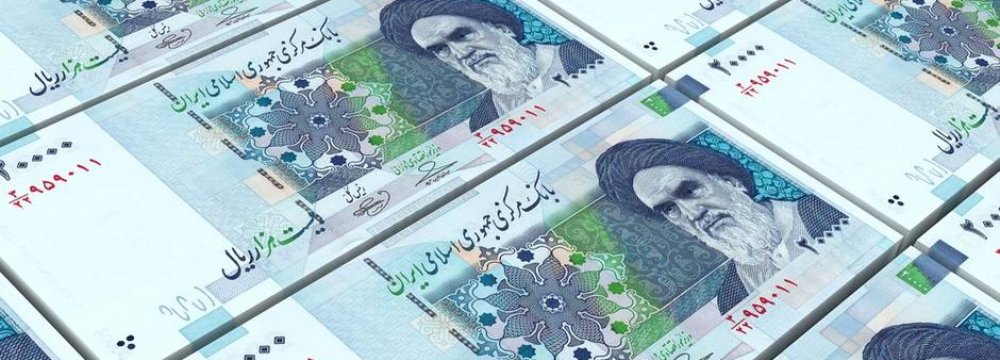
Monetary Base Growth Raising Inflationary Fears


The assessment of economic data reveals that the reckless increase in monetary base has been the main reason for the surge in inflation in the past. President Hassan Rouhani’s administration largely managed to keep the inflation growth in check by controlling the monetary base in recent years but recently, the growth rate has witnessed signs of resurgence.
There are a number of variables that determine the changes in monetary base which, in turn, directly impacts the inflation rate.
Central Bank of Iran’s foreign assets, government arrears and banks’ debts to CBI and a number of other factors influence the monetary base growth.
The CBI report for the month ending February 18 indicates that the government’s debts to the central bank grew by 10.9% at an annualized rate to reach 597.5 trillion rials ($16 billion).
The administration accounted for 338.6 trillion rials ($9 billion) or 56.66% of the total debts with an annual growth of 28.3% while state-run companies reduced their debts by 5.8% at 258.9 trillion rials ($7 billion) but they are still responsible for 43.34% of the government’s total debts to CBI.
Although the government’s debt to CBI is one of the reasons behind monetary base growth, the main reason is banks’ debts to CBI, which surged dramatically last year.
The data show banks’ debts to CBI reached 1.1 quadrillion rials ($30 billion) by the end of the Iranian month of Bahman (ended Feb. 18), marking a 35.3% growth year-on-year. This is while during the same time last year, the figure had dropped by 1.2%.
Snowballing Debt
Government measures to keep its payment arrears to CBI in check have been offset by the significant leap in banks’ debts to CBI.
The three government-run commercial banks lightened their debts to CBI by 2.4% during the 11-month period and the figure shrunk to 147.1 trillion rials ($4 billion) compared with the same time last year.
Private banks, however, witnessed a whopping surge of 193.9% in their debts to CBI to reach 405.3 trillion rials ($10.8 billion).
Despite the leap in private banks’ debts to CBI, the five state-owned specialized banks still account for the biggest share of debts to CBI at 602.5 trillion rials ($16 billion), marking an increase of 6.6% YOY.
CBI’s foreign assets almost stayed unchanged compared with the same period of last year. The figure rose to 3,384.5 trillion rials ($90.2 billion) from 3,379.7 trillion rials ($90.1 billion), showing a slight 0.1% increase.
If the amount of banks’ debts keeps piling up, the growth in monetary base will accelerate and threaten the hard-earned single-digit inflation rate.
Since some of these private banks and credit institutions do not have a verified strategy to repay those debts, the idea of their infrastructural reform comes to the fore.
Liquidity is an amalgamation of money and near money. In economic literature, money refers to all the current deposits, cash and coins, while all the term deposits are considered near money. If the money grows faster than near money, it shows a drop in banks’ term deposit, making it harder for them to lend.
Studies also show that the faster growth of money compared with near money will also stoke inflation.
Currently near money accounts for 87.4% of the liquidity that stands at 10,588.3 trillion rials ($282.3 billion), marking a growth of 24.2% compared with the corresponding period of last year. The remaining liquidity comprises 1522.6 trillion rials ($40.6 billion).


Trump weighs using $2 billion in CHIPS Act funding for critical minerals

Codelco cuts 2025 copper forecast after El Teniente mine collapse

Electra converts debt, launches $30M raise to jumpstart stalled cobalt refinery

Barrick’s Reko Diq in line for $410M ADB backing

Abcourt readies Sleeping Giant mill to pour first gold since 2014

Nevada army depot to serve as base for first US strategic minerals stockpile

SQM boosts lithium supply plans as prices flick higher

Viridis unveils 200Mt initial reserve for Brazil rare earth project

Tailings could meet much of US critical mineral demand – study

Kyrgyzstan kicks off underground gold mining at Kumtor

Kyrgyzstan kicks off underground gold mining at Kumtor

KoBold Metals granted lithium exploration rights in Congo

Freeport Indonesia to wrap up Gresik plant repairs by early September

Energy Fuels soars on Vulcan Elements partnership

Northern Dynasty sticks to proposal in battle to lift Pebble mine veto

Giustra-backed mining firm teams up with informal miners in Colombia

Critical Metals signs agreement to supply rare earth to US government-funded facility

China extends rare earth controls to imported material

Galan Lithium proceeds with $13M financing for Argentina project

Kyrgyzstan kicks off underground gold mining at Kumtor

Freeport Indonesia to wrap up Gresik plant repairs by early September

Energy Fuels soars on Vulcan Elements partnership

Northern Dynasty sticks to proposal in battle to lift Pebble mine veto

Giustra-backed mining firm teams up with informal miners in Colombia

Critical Metals signs agreement to supply rare earth to US government-funded facility

China extends rare earth controls to imported material

Galan Lithium proceeds with $13M financing for Argentina project

Silver price touches $39 as market weighs rate cut outlook

















